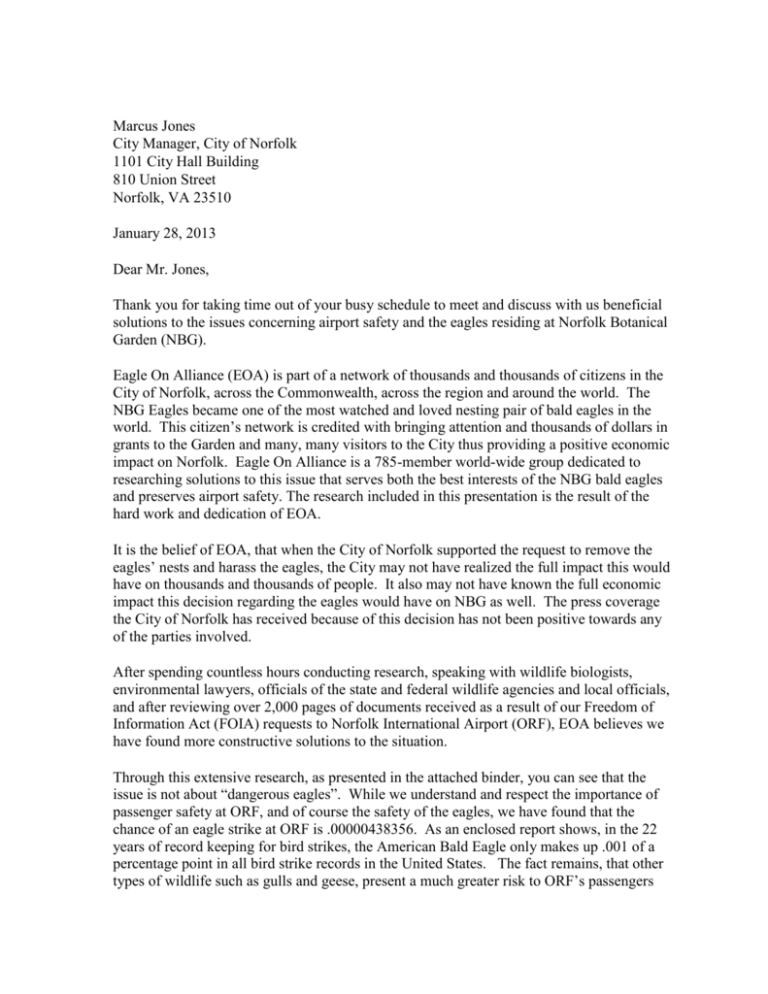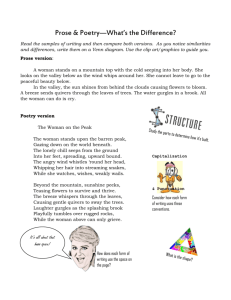Marcus Jones Cover Letter
advertisement

Marcus Jones City Manager, City of Norfolk 1101 City Hall Building 810 Union Street Norfolk, VA 23510 January 28, 2013 Dear Mr. Jones, Thank you for taking time out of your busy schedule to meet and discuss with us beneficial solutions to the issues concerning airport safety and the eagles residing at Norfolk Botanical Garden (NBG). Eagle On Alliance (EOA) is part of a network of thousands and thousands of citizens in the City of Norfolk, across the Commonwealth, across the region and around the world. The NBG Eagles became one of the most watched and loved nesting pair of bald eagles in the world. This citizen’s network is credited with bringing attention and thousands of dollars in grants to the Garden and many, many visitors to the City thus providing a positive economic impact on Norfolk. Eagle On Alliance is a 785-member world-wide group dedicated to researching solutions to this issue that serves both the best interests of the NBG bald eagles and preserves airport safety. The research included in this presentation is the result of the hard work and dedication of EOA. It is the belief of EOA, that when the City of Norfolk supported the request to remove the eagles’ nests and harass the eagles, the City may not have realized the full impact this would have on thousands and thousands of people. It also may not have known the full economic impact this decision regarding the eagles would have on NBG as well. The press coverage the City of Norfolk has received because of this decision has not been positive towards any of the parties involved. After spending countless hours conducting research, speaking with wildlife biologists, environmental lawyers, officials of the state and federal wildlife agencies and local officials, and after reviewing over 2,000 pages of documents received as a result of our Freedom of Information Act (FOIA) requests to Norfolk International Airport (ORF), EOA believes we have found more constructive solutions to the situation. Through this extensive research, as presented in the attached binder, you can see that the issue is not about “dangerous eagles”. While we understand and respect the importance of passenger safety at ORF, and of course the safety of the eagles, we have found that the chance of an eagle strike at ORF is .00000438356. As an enclosed report shows, in the 22 years of record keeping for bird strikes, the American Bald Eagle only makes up .001 of a percentage point in all bird strike records in the United States. The fact remains, that other types of wildlife such as gulls and geese, present a much greater risk to ORF’s passengers than eagles. In addition, documentation received through our FOIA requests to ORF shows that the underlying issue is budgetary and insufficient wildlife mitigation efforts by ORF. Reports show that although the United States Department of Agriculture (USDA-APHIS) recommended a larger budget for mitigation efforts, ORF’s management questioned the estimate, and requested a budget for half of the amount recommended. Documentation shows that a USDA staff person only works 60 hours a month at the airport which includes airport services and now NBG services. This equates to less than three hours a day. ORF has stated that they have other staff members to assist with mitigation, but ORF staff members only provide mitigation services as a “collateral” duty. And wildlife mitigation does not appear as a “line item” on ORF’s annual budget. From the very beginning, NBG Eagle advocates asked the City to delay requesting a permit for nest removal to form a committee to study all other mitigation options. One request that was repeatedly mentioned during discussion, emails and public comments was the use of Avian Radar Systems to assist with all wildlife strikes at ORF. While ORF’s Executive Director Wayne Shank indicated to The Virginian-Pilot that the airport had looked into this as an option for airport safety, he also added that radar is a tool that would not have avoided the death of two eagles in 2011. We strongly disagree. In the binder, you will find that all research we conducted shows that Avian Radar, while relatively new technology, is already making an impact in the reduction of bird strikes at private, commercial and military airports. In fact, the FAA has endorsed the use of Avian Radar Systems to the point that they are offering AIP grant funds to Part 139 airports. ORF is a Part 139 airport and would be eligible for these grants. While Mr. Shank said that the death of the two eagles wouldn’t have been prevented, our research shows that the death of the NBG female eagle (“Mom Norfolk”) could have been prevented by either proper mitigation efforts or through an Avian Radar system. Airport tower reports that we have included today show that the airplane pilot that landed on “Mom Norfolk” reported to air traffic control that two eagles were seen eating a fish on the end of the runway. Instead of telling the pilot to fly over while the eagles were dispersed, no word of caution was received from the tower and the pilot proceeded to land on the female eagle. The strike report states that pilots were not warned of wildlife in the vicinity. The male eagle, fortunately, flew off. But sadly, the female eagle was killed, causing damage to the landing gear when she rose to get out of the way. If Avian Radar had been in place, an alarm would have alerted air traffic control and the incoming flight of the presence of the eagles in the vicinity. Avian Radar systems can track the movement of almost all wildlife in air space both vertically and horizontally. While the events that occurred on April 26, 2011 were unfortunate, what is even more troubling is that the NBG eagles have become a scapegoat for improper mitigation efforts at ORF. The picture presented by ORF to wildlife agencies and the City of Norfolk indicated that the eagles at NBG had suddenly become an emergency threat to life and property even though the eagles have nested at the Garden for more than ten years. US Fish and Wildlife Services and the USDA convinced City of Norfolk officials that they had no choice but to support the next step of nest removal as the way to solve the problem. The FAA merely recommended removal. Scare tactics were used to convince the City Manager’s Office that there was no choice but to remove the nests. As our research shows, there actually was another option that could have been included in the City of Norfolk’s application for a nest removal permit and something that could have been addressed by USFWS and the USDA if any research had been done by the city prior to applying for the permit. Federal Register document dated September 11, 2009, US Department of Interior Fish and Wildlife Service, 50 CFR Parts 13 and 22, Eagle Permits; “Take Necessary to Protect Interests in Particular Localities; Final Rule” indicates that through these rules, the City of Norfolk could have asked for the permit to allow the USFWS and USDA to relocate the nest to an alternate location or provide a substitute nest in a safe area of the eagles’ territory and attract the eagles to those safer locations. On page 44, Section 22.27, Removal of Eagles Nests, (a) (2), it states “Where practicable and biologically warranted, the permit may require a nest to be relocated, or a substitute nest provided, in a suitable site within the same territory to provide a viable nesting option for eagles within that territory, unless such relocation would create a threat to safety. However, we may issue permits to remove nests that we determine cannot or should not be relocated.” In discussions with Eliza Savage, Division of Migratory Bird Management, U.S. Fish and Wildlife Service at the Department of Interior in Arlington, Virginia, who is the Department’s contact for this document, she stated that the option of nest relocation was indeed a possibility for the NBG eagles. Her office is well aware of the NBG eagles and the efforts of Eagle On Alliance. She advised that we indeed ask the City of Norfolk why this provision was not included in the original nest removal permit application. Ms. Savage also suggested we contact Sarah Nystrom in the Region 5 office of USFWS in Hadley, Massachusetts, the office that issued Norfolk’s nest removal permit. Ms. Nystrom is also well aware of the plight of the eagles at NBG and was quite helpful in addressing this issue. She advised that normally the relocation efforts are begun ahead of actual nest removal but that it is not too late to put plans into place. She is looking into procedures and the need for additional permits. We believe this plan may provide a solution for the airport, the eagles, NBG and the City of Norfolk. We would like to join the City Manager’s Office to make a formal announcement that a resolution has been presented. In addition, this solution will allow more time for ORF and the City of Norfolk to research Avian Radar systems – a much better alternative for protecting our passengers and all of the wildlife surrounding ORF. We hope that you will consider this as one of the options as we move forward. We are ready to partner with your office on a more sensible solution and tell the thousands of supporters and the media that the City of Norfolk will, indeed, do the right thing. Again, please accept this letter as an official request from Eagle On Alliance that the City of Norfolk revoke the USFWS Eagle Nest Removal permit and delay by one year any further removal of nests and any further harassment of the NBG eagles. At some point, there has to be a realization that both man and Mother Nature can coexist side by side. The challenges of wildlife existing near airports have been solved by many other communities by using some of the recommendations we have listed. Let’s solve those challenges in Norfolk, too. Sincerely, Carol F. Senechal Founder, Eagle On Alliance Tommy Smigiel City of Norfolk Councilman, Ward 5






